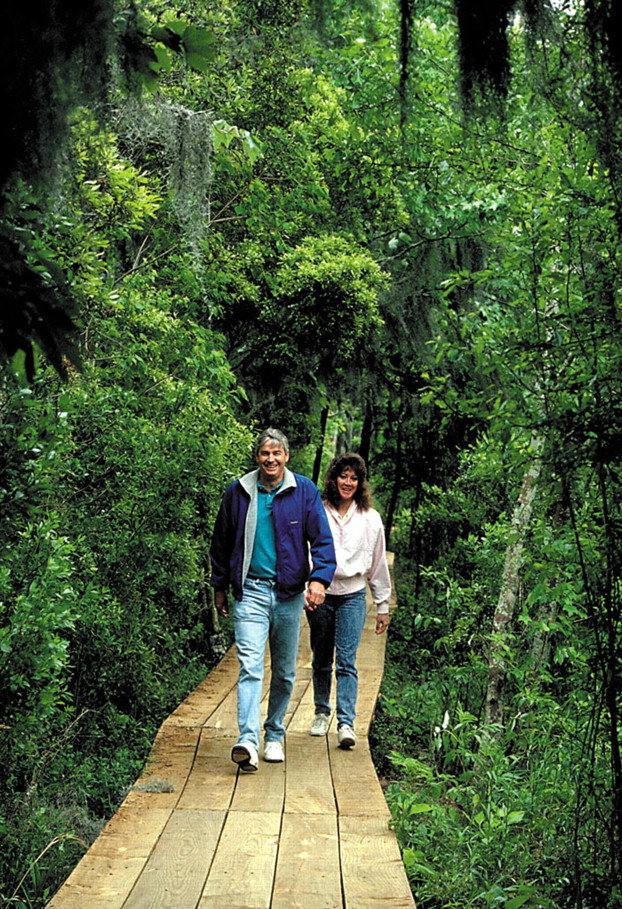Park Yourself Here to Learn About Louisiana’s Wildlife

Visitors to the Jean Lafitte system of parks will learn about Louisiana’s diverse natural and cultural history.
Established in 1978 to preserve the rich land and culture of the Mississippi Delta and its settlers, Jean Lafitte National Historical Park and Preserve covers more than 20,000 acres and a variety of terrains. Among the park’s six sites visitors will find an Acadian cultural center, a nature preserve, and a battlefield. Whether park visitors want to learn more about the origins of Louisiana culture or just spend some time in the great outdoors, each of the sites has something unique to offer:
• Acadian Cultural Center: Located in Lafayette, La., the center explores the culture of the Acadian people, now known as the Cajuns. The Acadian people migrated from western France to present-day Nova Scotia in early 1604 and prospered in fishing and farming. After Great Britain acquired control of this land in the early 1700s, it began removing the Acadian people from their new home. Some of the displaced families found their way to Louisiana, and by the beginning of the 19th century, there were 3,000 to 4,000 Acadians settled in Louisiana.
The park is open daily from 9 a.m. to 5 p.m. Visitors can view a 40-minute film, “The Cajun Way, Echoes of Acadia,” hourly from 9 a.m. to 4 p.m. More information is available by calling (337) 232-0789.
• Wetlands Acadian Cultural Center: Located in Thibodaux, La., along the Bayou Lafourche, the cultural center features exhibits about the Acadian people who settled on the swamps, marches, and coastal waters of Louisiana.
The center features talks by a park ranger on Saturdays and Sundays at 11 a.m. and 2 p.m., and music programs on Mondays from 5:30 p.m. to 7 p.m. The center is open Monday from 9 a.m. to 7 p.m., Tuesday through Thursday from 9 a.m. to 6 p.m., and Friday through Sunday, from 9 a.m. to 5 p.m. More information is available by calling (504) 448-1375.
• Prairie Acadian Cultural Center: Located in Eunice, La., this center showcases the heritage of the Acadians who settled in southwestern Louisiana’s grasslands, where settlers earned a living farming crops and raising cattle. The center examines the recreation, clothing, home furnishings, religion, and cuisine of the prairie Acadians through exhibits and live demonstrations.
The center is open Sunday through Friday from 8 a.m. to 5 p.m., and Saturdays from 8 a.m. to 6 p.m. More information is available by calling (337) 262-6862.
• Barataria Preserve: Located in Marrero, La., this nature preserve encompasses about 20,000 acres of hardwood forest, cypress swamp, and freshwater marsh. Plant life is varied, with oak forests growing on part of the preserve and a dense palmetto forest in another. There are eight miles of hiking trails for visitors to stroll through, including two-and-a-half miles of boardwalk. Additionally, there are more than 20 miles of waterways and nine miles of canoe trails closed off to motorized boats for a more peaceful excursion.
The center is open daily from 9 a.m. to 5 p.m. There are canoe treks on Sunday mornings at 8:30, and moonlight canoe treks on the night before and the night of a full moon, though reservations are required. Daily history walks are held at 2 p.m. More information is available by calling (504) 589- 2330.
• Chalmette Battlefield and National Cemetery: Located in Chalmette, La., this attraction preserves the site of the January 8, 1815, Battle of New Orleans, which resulted in an American victory over the British at the end of the War of 1812. To explore the battlefield and its history, there is a tour road, visitor center, and the Malus-Beauregard House, which was built 18 years after the Battle of New Orleans. Next to the battlefield is the Chalmette National Cemetery, which was established in 1864 as the resting place for Union soldiers who died in Louisiana during the Civil War. Men who fought in a number of other wars from the Spanish-American War to the Vietnam War are also laid to rest here.
Battle of New Orleans talks are given daily at 11:15 a.m. and 2:45 p.m., and living history demonstrations on the second Saturday of each month. The battlefield is open daily from 9 a.m. to 5 p.m. More information is available by calling (504) 589-2330.
• French Quarter Visitor Center: Located in the French Quarter of New Orleans at 419 Decatur Street, the center features the history and cultural diversity of Louisiana’s Mississippi Delta region.
A walking tour called “History of New Orleans” is held daily at 10:30 a.m., and passes must be picked up in person on the day of the tour. More information is available by calling (504) 589-2636.
The Jean Lafitte National Historical Park and Preserve Headquarters is located in New Orleans at 365 Canal Street. More information about the park can be obtained by visting the Web site www.nps.gov/jela or calling the headquarters at (504) 589-3882, ext. 100. ▪



